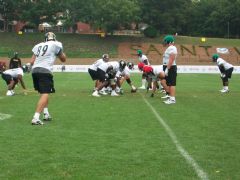The game was the tenth Super Bowl hosted by the city of New Orleans (an NFL record) but the first since Hurricane Katrina devastated the area in 2005. With the teams being coached by the Harbaugh brothers, the eldest sibling, John came out on top as his Ravens outscored his brother Jim's 49ers by 34 - 31.
However, in my opinion, the most important headline in the NFL media was that created by DeMaurice Smith, in his NFL Players' Association "State of the Union" address. Smith voiced his opinion that effectively the NFL doesn't care enough about player safety, with league rules on medical staffing failing to ensure quality of care.
The NFLPA had canvassed its members & found that the overwhelming majority had no confidence in the quality of the medical care made available to them. In fact, on a scale of 1 - 5, with 1 indicating the player had complete trust in the medical staff & a 5 indicating a complete lack of trust in the medical staff, 78% selected the 5 rating, whilst a further 15% selected the 4 rating.
That's an astonishing 93% of players surveyed voicing serious concerns about their provision of care - I can't imagine a group of athletes agreeing so unanimously on anything, let alone something as critical to an athlete's well-being as their medical care.
The question I asked myself, is that given what I have seen in the medical & training departments in American sports teams in comparison to their counterparts operating in European & Australasian teams, does that really surprise me? Unfortunately the answer is no & I'll tell you why.
I haven't seen such a low ratio of therapy, sports science & strength & conditioning staff to players outside of North America. The rosters at these franchises are huge & represent incredible financial investment, yet the resources allocated to the teams that support the well-being & performance of the players demonstrates a gross mismatch. I can't imagine a Premier League soccer team with so few physiotherapy staff to so many players & I have yet to come across a rugby team that would provide so few man hours of strength & conditioning time as I have seen in teams across the Atlantic. As for sports science - the story is much the same.
The mindset seems to be one of "look, if he breaks, there are plenty others that will take his place", as opposed to one of "this guy is worth investing in & looking after, especially considering he came out on top in the draft". Is it any wonder that the average playing career in NFL is so much shorter than one in rugby union...& you can't tell me the physical demands are any more attritional in the rugby code.
This isn't the fault of the guys working in these departments, the blame in my eyes lays squarely at the feet of the money men whose emphasis appears to focus on having all the fancy equipment as opposed to assembling adequate numbers of skilled clinicians to work in these incredible facilities.
It's about time that the coaches started asking questions too. The EPL asked an interesting question a few years back in order to establish what the optimal player turnover for a team was in relation to on-field success. I can't find the report on the study but the number sticks vividly in my head - 2.
The most successful teams recruited just 2 new players per season & when you think about retaining a team's ethos, or hours of practice spent with the same playing staff, you can see the sense in that.. Get rid of a couple to freshen things up & keep complacency at bay but maintain a consistent environment that a small number of new players can be quickly assimilated in to.
Now compare that to the extensive playing staff turnover in American sports - at times a majority of the roster is replaced due to injury or trade between seasons. How on earth is that going to facilitate the momentum of a successful team? How much time must be wasted trying to re-establish what the team's ethos is, learning new plays with chunks of a line having been replaced, or helping players settle in to a new environment?
The system makes it so much harder for coaches to achieve success, whereas if the systems & staff could be put in place to ensure a reduction in the number of valuable players cut through injury, this turnover could be curtailed.
But maybe the owners can't help themselves - they see immediate productivity figures at the expense of organisational health. In the long term this strategy has been shown to stand in the way of consistently repeated success, but it involves taking some calculated risks to profit in the short term.
So if the owners can't be trusted to initiate such a strategy to solve this unhappy situation, then Commissioner Roger Goodell has to take a lead by putting certain rules in place to force their hand. That is what the Football Association did, that is what the Premier League has done & the International Rugby Board too & interestingly when we got the opportunity to speak to Commissioner Goodell at the Steelers' training camp back in 2010, he was asking Mutchy & myself about the medical provision in these sports.
So now's the time to act Roger...because the players are taking matters into their own hands & sourcing their own support staff away from their clubs & that isn't an optimal solution either. That just opens the market up to unscrupulous charlatans with silver tongues that can take advantage of the fear demonstrated by players who feel they have nowhere else to turn & further alienates the hard working staff in your teams.

